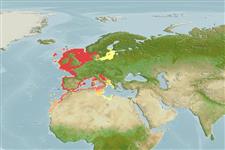Classification / Names
Common names from other countries
Main reference
Size / Weight / Age
Max length : 69.0 cm TL male/unsexed; (Ref. 10536); 83.0 cm TL (female); common length : 40.0 cm TL male/unsexed; (Ref. 2945); common length :70 cm TL (female); max. published weight: 4.0 kg (Ref. 30578); max. reported age: 10 years (Ref. 10536)
Length at first maturity
Lm 48.1, range 45 - 50 cm
Environment
Marine; freshwater; brackish; pelagic-neritic; anadromous (Ref. 89642); depth range 10 - 300 m (Ref. 10536)
Climate / Range
Temperate, preferred 16°C (Ref. 107945); 61°N - 20°N, 17°W - 22°E
Distribution
Eastern Atlantic: from southern Norway and along the coasts of Europe to northern Mauritania (Ref. 188, 6683), including the Western Baltic Sea up to the Kaliningrad Oblast (Ref. 12801, 26334, 59043), the western part of Mediterranean Sea (Ref. 188, 6683, 59043) and the coast of northern Africa (Ref. 3509). Outside France this species is rare (Ref. 89646).
Listed in Appendix III of the Bern Convention (2002).
Listed in Annex II and V of the EC Habitats Directive (2007).
Countries | FAO areas | Ecosystems | Occurrences | Introductions
Short description
Dorsal
spines
(total): 0;
Dorsal
soft rays
(total): 18-21;
Anal
spines: 0;
Anal
soft rays: 20 - 27;
Vertebrae: 57 - 58. Diagnosis: Body somewhat compressed, fairly deep with depth at pectoral fin more than head length, scutes apparent along belly (Ref. 188, 51442). Upper jaw notched, lower jaw fitting into it; no teeth on vomer; gillrakers long, thin and numerous, a total of 85 to 130, longer than gill filaments (Ref. 188). A dark spot posterior to gill opening, but sometimes absent, occasionally 1 or 2 more spots (Ref. 188). Alosa alosa resembles Alosa fallax, which has fewer and shorter gillrakers and 7 or 8 black spots along flank (Ref. 188).
IUCN Red List Status (Ref. 115185)
Threat to humans
Harmless
Human uses
Fisheries: minor commercial; gamefish: yes
Tools
Special reports
Download XML
Internet sources
Estimates of some properties based on models
Phylogenetic diversity index
PD50 = 0.5000 many relatives (e.g. carps) 0.5 - 2.0 few relatives (e.g. lungfishes)
Trophic Level
3.0 ±0.2 se; Based on diet studies.
Resilience
Medium, minimum population doubling time 1.4 - 4.4 years (K=0.19-0.29; tm=3.5; tmax=10)
Vulnerability
Moderate vulnerability (36 of 100)
Price category
